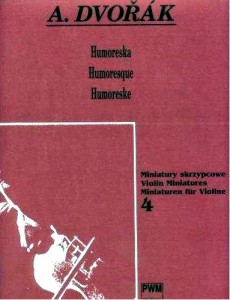ABSTRACT
It likely invokes a state of calmness and tranquility to induce sparkles of delight and pensiveness…

 Antonín Dvořák’s Humoresque No. 7 in G-flat major is often heard as a popular violin miniature or encore piece. I remember the very first time I listened to it was from a 10”-vinyl disc (comprising violin gems) that brother YH bought during his high school years when I was in grade school. This simple and pleasant melody immediately struck my heartstrings. Since then I had been imagining taking up the violin some day so that I could play it. As an adult, I finally learned the Shin’ichi Suzuki simplified arrangement
Antonín Dvořák’s Humoresque No. 7 in G-flat major is often heard as a popular violin miniature or encore piece. I remember the very first time I listened to it was from a 10”-vinyl disc (comprising violin gems) that brother YH bought during his high school years when I was in grade school. This simple and pleasant melody immediately struck my heartstrings. Since then I had been imagining taking up the violin some day so that I could play it. As an adult, I finally learned the Shin’ichi Suzuki simplified arrangement
[http://www.youtube.com/watch?v=-MTyhj3gyI0&NR=1&feature=fvwp]
but played it, as expected, without conveying humor.
Humoresques are fanciful romantic pieces that depict a humorous mood. Dvořák originally wrote eight of them in 1894 as a cycle of piano ditties, which were published as his opus 101
[http://imslp.org/wiki/8_Humoresques,_Op.101_%28Dvo%C5%99%C3%A1k,_Anton%C3%ADn_Leopold%29].
The popular tune arranged for the violin is the seventh designated poco lento e grazioso–a little slow and gracious
[http://www.youtube.com/watch?v=WmAZoexenx8].
Fritz Kreisler popularized it further with his own fancy arrangement and played it with much sentiment [http://www.youtube.com/watch?v=UiiAUECbIaw]. Hilary Hahn, the young American violinist, however, admires Mischa Elman’s rendition
[http://www.youtube.com/watch?v=31uJT2IKsR0&feature=related]. Elman played it methodically and slowly with such a precision that exemplified the even bowing division technique, yet adding colors to it. On the other hand, the violin virtuoso Maxim Vengerov interprets it speedily like a child skipping rope
[http://www.youtube.com/watch?v=f_JoPEX3pxc].
One of my teachers introduced me to yet another interpretation, one by Josef Hassid, who died tragically and prematurely. He recorded Kreisler’s version but played it with unique articulation and subdued melancholic passion
[http://www.youtube.com/watch?v=EpMiNez6RR4].
Dvořák’s Humoresque No. 7 has been transcribed for various instruments and ensembles. Even a song version was used as a joke on the Amtrak train and in a children’s animation. It is not surprising that its original piano version is unknown to or forgotten by some listeners, while its violin and piano versions remain in the popular repertoire. Many violinists, from the very young to the old, have played it. Listeners respond to it in more than a humorous mood as provoked by the artist’s interpretation and delivery. It likely invokes a state of calmness and tranquility to induce sparkles of delight and pensiveness. I recently came across a performance by Rachel Barton Pine, playing Maud Powell’s adaptation of Kreisler’s arrangement
[http://www.youtube.com/watch?v=O9AUhoQZOrw]. You may choose your favorite interpretation from all available versions.